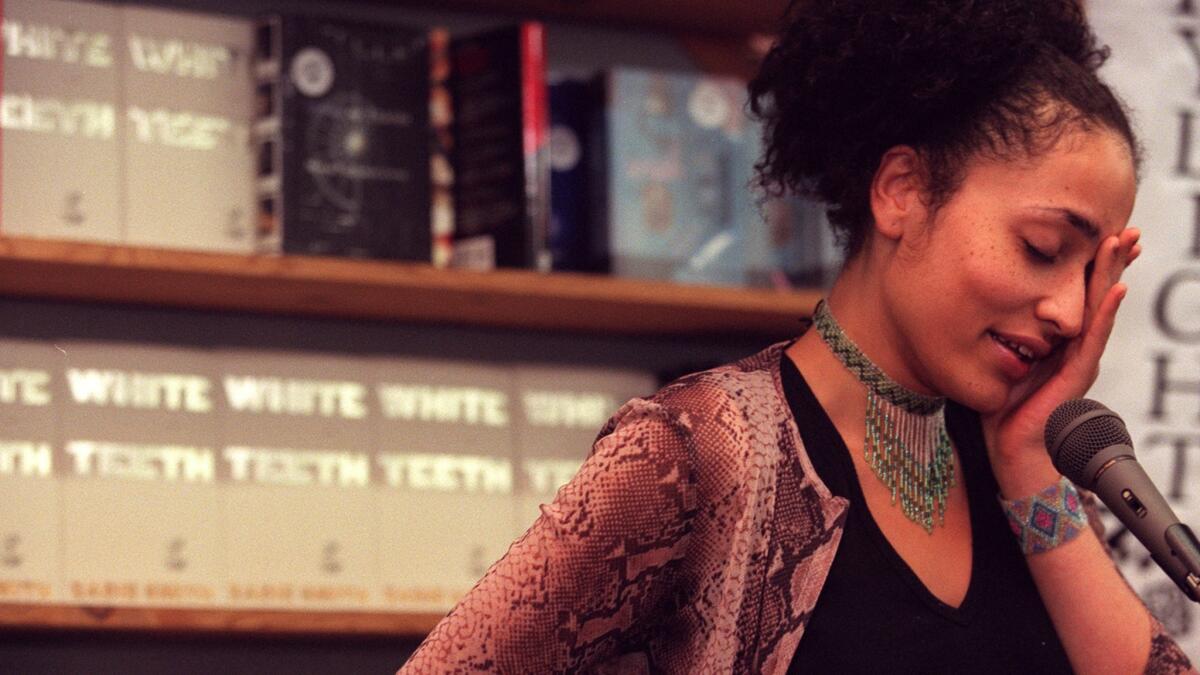Review: Zadie Smith’s brilliance is on display in ‘Feel Free’

- Share via
Upon opening “Feel Free,” Zadie Smith’s new essay collection, you’ll be surprised to learn that she doubts her literary talent, her critical acumen. I suppose that many literary writers are skeptical or anxious about their chosen profession. I know I am: though some invisible force compels us to create, we writers sometimes feel ourselves fraudulent intellectually, not knowing enough about anything to represent human experience or critique the arts successfully. Smith ought not be one of those writers though. Since 2000, Smith — London born and bred, now a New Yorker — has published six substantial, exceptional works of fiction (including the 2012 novel “NW,” a tour de force formally and stylistically) and an excellent work of nonfiction, “Changing My Mind: Occasional Essays” (2009).
Across her eighth book’s five parts — “In the World,” “In the Audience,” “In the Gallery,” “On the Bookshelf,” “Feel Free” — Smith has distributed a slew of essays, reviews (including a folio of “Harper’s” columns) and lectures written from 2009-17. Over the course of 435 pages, she covers Brexit and the waning British state; climate change; David Fincher, Facebook and internet 2.0; Billie Holiday; Joni Mitchell; Key & Peele; Schopenhauer, Charlie Kaufman and stop-motion animation; black beauty, black sorrow, oil painting and a horror movie about white liberals; the vagaries of lower-middle-class British life in the 1980s and ’90s; literary fiction and the discontinuous self; Justin Bieber, Jay-Z and joy.
Smith’s continuous stream of productivity, her topical range, the accolades laureling her books, her prodigious artistic abilities, should be evidence enough to assuage her fears about credibility. And yet, as Smith explains in the new collection’s foreword, her anxiety arises from believing she has “no real qualifications” to write as she does. “Not a philosopher or sociologist, not a real professor of literature or film, not a political scientist, professional music critic or trained journalist,” Smith thinks that her essays rest shakily on evidence that is “almost always intimate. I feel this — do you? I’m struck by this thought — are you?” She worries that her writing has “not a leg to stand on” because it’s born from “affective experience” and not argument. “All [the essays] have is their freedom. And the reader is likewise unusually free, because I have absolutely nothing over her, no authority.”

Smith, of course, has authority: It often arises from her sentence-level precision, the refined elucidation of her insights, the exuberance and humor that sustains readers’ attention. It’s there when she parses Hanif Kureishi’s “The Buddha of Suburbia” and J.G. Ballard’s “Crash”; it’s there in the hyper-intelligent micro reviews from “Harper’s.” Taking up Edward St. Aubyn’s novel, “At Last” (2012), for example, Smith describes how the author draws from “the wit of Wilde, the lightness of Wodehouse and the waspishness of Waugh” as he fashions his meticulous personal style:
“Oh, the semicolons, the discipline! Those commas so perfectly placed, so rhythmic, creating sentences loaded and blessed, almost o’erbrimmed, and yet sturdy, never in danger of collapse. It’s like fingering a beautiful swatch of brocade. This refusal to submit to the puritan brevity of the American sentences (or, worse, the artificial naivety of an English sentence intended to sound as if it has been translated from the French) — it’s almost enough to make you feel patriotic.
These sentences aren’t merely decorative. They’re important because they enable the comedy: when you create this many compartments in each line, you have space for at least two jokes and one sly dig.”
Effectively a pastiche of St Aubyn’s style, Smith’s close reading illustrates and explicates simultaneously. She’s also performing what I’ll call her “affective” critical practice. Smith seems to define that mode while appraising the intellectual prowess on display in Geoff Dyer’s “Otherwise Known as the Human Condition: Selected Essays and Reviews.” When she writes that each of Dyer’s essays “is an attempt to respond in kind, to be equal to the artwork, in some way to meld with it, like a love object,” Smith could be describing her own approach. Pastiche melds the critic to the love object and creates intimate, meaning-driven analysis.
When writing about singers and rappers, Smith’s pieces seem shaped by the sonic motions of musical voices. In “Some Notes on Attunement,” Smith responds pastiche as in kind to Joni Mitchell and her 1971 album, “Blue.” Like a literary approximation of Mitchell’s wandering notes, Smith wanders through Wordsworth, Kierkegaard, Abraham and Isaac, connoisseurship, novel reading (and writing) and the Talking Heads to get to Mitchell.
Considering Mitchell’s own artistic and personal transformations, Smith points out that “these days, Mitchell thinks of herself more as a painter than a singer. She is so allergic to the expectations of her audience that she would rather be a perfectly nice painter than a singer touched by the sublime.” Mitchell’s life demonstrates the “inconsistency of identity, of personality.”
Attuning to Mitchell, Smith realizes that while she herself is both “the girl who hated Joni and the woman who loves her,” they’re divorced from each other. Recognizing her own discontinuities allows Smith to notice “the transformation of [her] listening,” shifting away from hating Mitchell to a space where “Blue” triggers “uncontrollable tears. An emotional overcoming, disconcertingly distant from happiness, more like joy — if joy is the recognition of an almost intolerable beauty. It’s not a very civilized emotion.” In transformation, in the gap between separated selves, Smith finds freedom, the portal to joy.
But there is dis-ease in this transition too. Our separation from our various selves, Smith writes, is an everyday sensation, “yet it proves a tricky sort of problem for those people who hope to make art. For though we know and recognize discontinuity in our own lives, when it comes to art we are deeply committed to the idea of continuity. I find myself to be radically discontinuous with myself — but how does one re-create this principle in fiction?” This professional literary problem is enmeshed with Smith’s apprehension about her intellectual authority.
In “Some Notes,” when Smith worries that she cannot develop a connoisseur’s command of, say, Mitchell’s or David Byrne’s music, or some other subject, her anxiety stems from a belief that she doesn’t have the time it takes to generate command. Like many of us just entering the long middle section of our lives, Smith’s time is taken up by work (writing and teaching writing), parenting two young children, and partnering an equally ambitious and prolific writer, her husband, Nick Laird. Life, in other words, strips time away from taking in or occludes altogether the newness and sublimity that strong artwork can provide.
One way to read “‘Crazy They Call Me’: On Looking at Jerry Dantzic’s Photos of Billie Holiday” is as an attempt to solve this riddle. Fashioning her introduction to the photos in “Jerry Dantzic: Billie Holiday at Sugar Hill” as a fictional memoir in Holiday’s voice, Smith makes the singer the beloved and tries equaling the wonder of her persona in Dantzic’s images. Smith merges her style partly with an imagined Holiday and partly with the sound of the singer’s memoir, “Lady Sings the Blues” (isn’t Holiday’s collaboration with her amanuensis, William Duffy, a form of melding?).
The voice Smith hears emanating from the pictures glides across various points of view to tell her story. Though she was born Eleanora Fagan and performed as Billie Holiday, the witty figure who emerges is angular and shifting: “though many aren’t hip to this yet — not only is there no more Eleanora, there isn’t any Billie either. There is only Lady Day.” It’s ventriloquism as loving, musical homage.
Like singers, writers create secondary or tertiary selves, using “them to slip from every bind and definition, but … can also prove callous with the lives of others and in their dash for freedom knock their loved ones out of the way.” As Smith argues late in “The Bathroom,” a funny, gorgeous, mournful essay about what their arrival in the British lower middle class cost her parents, family life “is always an event of some violence.” How then does the writer balance desired freedoms, minimize family as an event of violence, and access joy? Smith has built a career as a novelist dancing among these poles, dancing between (as the title of one her essay names it) optimism and despair.
Smith’s most recent novel, “Swing Time” (2016) is an attempt to wrestle with her doubts about fiction’s capabilities. To great effect, Smith achieves a formally unified literary novel while simultaneously illustrating a unnamed narrator recognizing her discontinuous selves. It’s a novel about dance that ends with a major character, Tracy, herself a lapsed professional dancer, joyously whirling dervish-like with her children. While Smith may not be able to assuage her doubts about her authority, she can “dance” with and around them. In fact, those dancing with doubt seems central to her “affective” critical process.
There’s so much at play in “Feel Free” that a reader might feel anxious about how to gain purchase on all of Smith’s ideas. “Getting In and Out,” “Mark Bradford’s ‘Niagara,’” “A Bird in a Few Words: Narrative Mysteries in the Paintings of Lynette Yaidom-Boakye,” present Smith’s most forceful writing yet about film, visual art and blackness. “The Bathroom,” “Love in the Gardens,” “The Shadow of Ideas” and “Joy” demonstrate Smith’s mastery of creative nonfiction and the essay form. However, as she points out in “The Tattered Ruins of the Map,” when confronted with the “rapidly revolving ideas,” the constellated materials, objects and digital images that make up Sarah Sze’s “Centrifuge,” “it is hard to know which element to separate from the rest. Yet if you are to write about something you must choose.”
Here, I’ve chosen the bits of this tremendous, enthralling book that might explain how Smith, in spite of her doubts about it, demonstrates authority. My hunch about this book is this: While paying attention to Smith’s doubts might get you into these essays, getting out may require some improvised dance moves.
That means, I think, rejecting linear movement through the work. This may not seem a proper way to address this work, but, as Smith writes in “Dance Lessons for Writers,” “between propriety and joy choose joy.” In any case, she’s suggesting that we follow her lead. Early in “Feel Free” Smith describes her writing as the intersection of language, the world, the self: “The first is never wholly mine; the second I can only ever know in a partial sense; the third is a malleable and improvised response to the previous two.” It’s this improvised Smith whom we’re dancing with throughout these pages.
Muyumba, associate professor of English at Indiana University-Bloomington, is the author of “The Shadow and the Act: Black Intellectual Practice, Jazz Improvisation, and Philosophical Pragmatism.”
::
Zadie Smith
Penguin Press: 464 pp, $28
More to Read
Sign up for our Book Club newsletter
Get the latest news, events and more from the Los Angeles Times Book Club, and help us get L.A. reading and talking.
You may occasionally receive promotional content from the Los Angeles Times.








